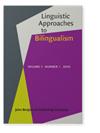Gender assignment strategies and L1 effects in the elicited production of mixed Spanish-Basque DPs
IF 1.8
2区 文学
0 LANGUAGE & LINGUISTICS
引用次数: 5
Abstract
This paper investigates the strategies involved in gender assignment in Spanish-Basque mixed Determiner Phrases (DPs) with a gendered Spanish determiner (el M /la F) and a Basque ungendered noun. Previous studies on Spanish-Basque mixed DPs have revealed conflicting results regarding the determining factor affecting gender assignment, namely, phonological ending vs. analogical gender. We designed a forced-switch elicitation task in order to elicit mixed DPs with a Spanish determiner and a Basque noun (controlled for both phonological vs. analogical cues). Thirty highly proficient Spanish-Basque bilinguals with different profiles and sociolinguistic backgrounds participated in the study. Three cues were significant in the selection of the Spanish M/F determiner: the analogical gender and two phonological cues, the word ending and the root ending of the Basque noun. Further statistical analyses revealed participants’ L1 as a strong factor in the variability attested: bilinguals with Spanish as (one of) their L1(s) rely predominantly on the analogical criterion, whereas speakers with only Basque as L1 follow mainly the phonological criterion. Overall, this study provides an explanation for the previous conflicting results and highlights the fact that bilinguals may use different strategies depending on their bilingual profile and the morpho-phonological properties of the languages in contact.性别分配策略和L1效应在西班牙-巴斯克混合DPs诱导生产中的作用
本文研究了西班牙语-巴斯克语混合限定词短语(DP)中的性别分配策略,该短语包含一个带有性别的西班牙语限定词(elM/laF)和一个巴斯克语无词根名词。先前对西班牙-巴斯克混血DP的研究揭示了关于影响性别分配的决定因素的相互矛盾的结果,即语音结尾与类比性别。我们设计了一个强制切换启发任务,以引出带有西班牙语限定词和巴斯克语名词的混合DP(控制语音和类比线索)。30名具有不同背景和社会语言背景的西班牙语-巴斯克语双语者参与了这项研究。在西班牙语M/F限定词的选择中,有三个线索是重要的:类比性别和巴斯克语名词的词尾和词根词尾这两个语音线索。进一步的统计分析显示,参与者的母语是变异性的一个重要因素:西班牙语为母语的双语者主要依赖类比标准,而只有巴斯克语为母语的说话者主要遵循语音标准。总的来说,这项研究为之前的相互矛盾的结果提供了解释,并强调了一个事实,即双语者可能会根据他们的双语特征和接触语言的形态-语音特征使用不同的策略。
本文章由计算机程序翻译,如有差异,请以英文原文为准。
求助全文
约1分钟内获得全文
求助全文
来源期刊

Linguistic Approaches To Bilingualism
Social Sciences-Linguistics and Language
CiteScore
3.20
自引率
9.10%
发文量
24
期刊介绍:
LAB provides an outlet for cutting-edge, contemporary studies on bilingualism. LAB assumes a broad definition of bilingualism, including: adult L2 acquisition, simultaneous child bilingualism, child L2 acquisition, adult heritage speaker competence, L1 attrition in L2/Ln environments, and adult L3/Ln acquisition. LAB solicits high quality articles of original research assuming any cognitive science approach to understanding the mental representation of bilingual language competence and performance, including cognitive linguistics, emergentism/connectionism, generative theories, psycholinguistic and processing accounts, and covering typical and atypical populations.
 求助内容:
求助内容: 应助结果提醒方式:
应助结果提醒方式:


